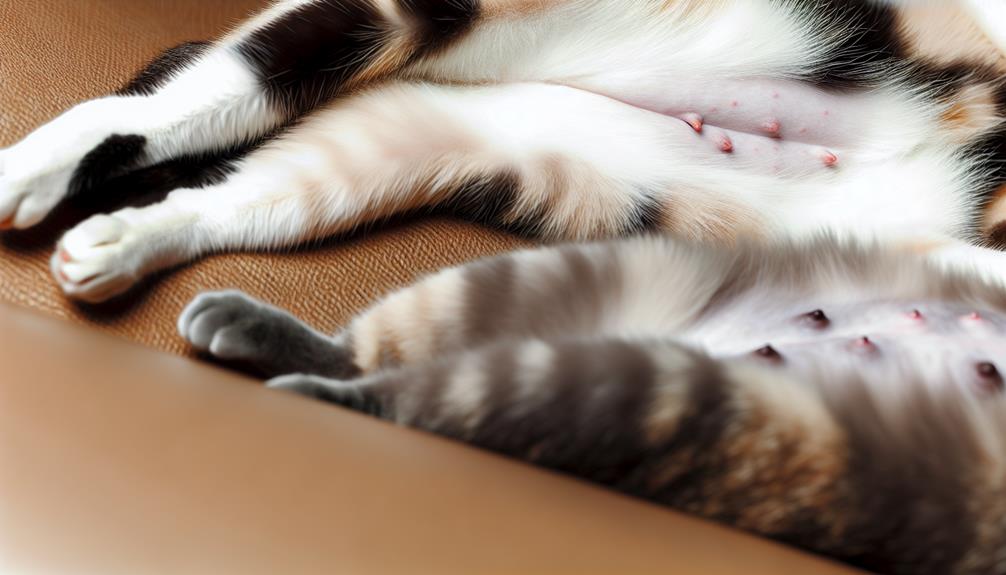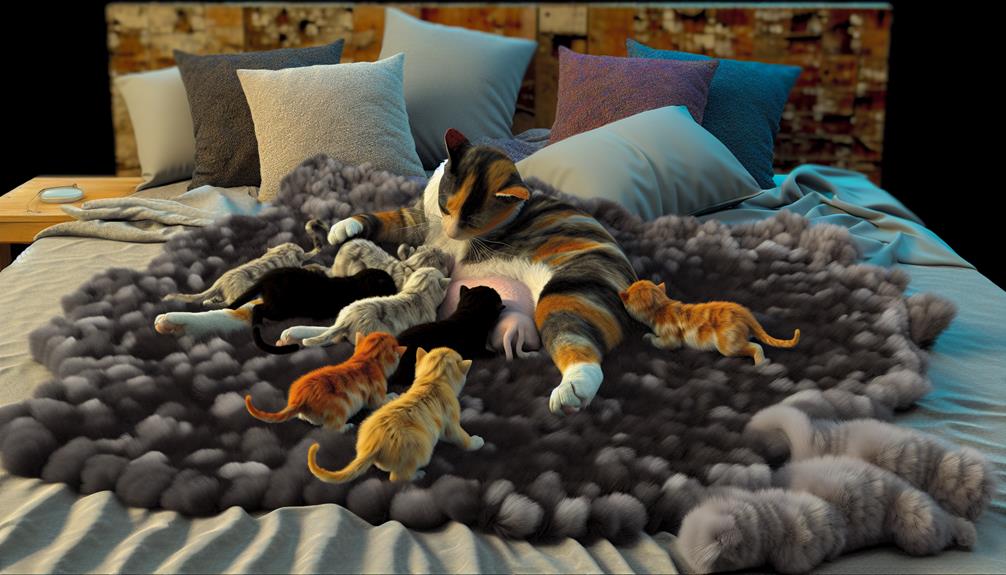You might be curious about how many nipples cats have and why it matters. Typically, cats have between six to eight nipples, arranged in two parallel rows along their belly. Although both male and female cats have them, only the females use theirs for nursing. The number isn't always consistent, and variations can occur due to genetic factors. But what implications does this variability have on their health and breeding? To understand this better, let's explore the nuances behind these intriguing details.
Average Number of Nipples
When examining felines, you'll find that the average number of nipples typically ranges from six to eight. This anatomical feature is essential in understanding feline anatomy, especially when considering the reproductive and nursing behaviors of cats. Typically, these nipples are arranged in two parallel rows along the ventral surface, extending from the thoracic to the abdominal region.
In terms of nipple count, each row generally has three to four nipples. However, it's significant to recognize that deviations from this pattern can occasionally occur, albeit infrequently. The presence of these nipples is not exclusive to the female cats (queens) but is also observed in male cats, although their functionality in males is redundant.
When you palpate a cat's abdomen, you'll notice that the nipples are relatively small and can be easily missed if not careful. They lack prominent areolae, making them less conspicuous compared to human nipples. This is a substantial aspect of feline anatomy, as it highlights the evolutionary adaptations cats have undergone.
Understanding the average nipple count is vital for veterinarians and feline breeders. It assists in monitoring the health of lactating queens and guarantees that kittens have adequate access to milk during the early stages of life. Anomalies in the number or appearance of nipples can sometimes indicate underlying health issues, necessitating further clinical investigation.
Variability Among Cats
Examining the average number of nipples in cats provides a foundation for understanding broader anatomical and physiological variations among felines. Typically, cats possess eight nipples, but this isn't a rigid rule. The number can vary, and this variability is a prime example of how genetic factors and developmental processes influence anatomical structures.
When you're observing nipple patterns in cats, you'll find that symmetry is common, yet not absolute. Most cats exhibit a bilaterally symmetrical arrangement, which means nipples appear in pairs along the ventral surface. However, some cats might present asymmetric patterns, where the number of nipples on one side doesn't match the other. These discrepancies, while less common, are perfectly normal and don't usually indicate any underlying health issues.
Anatomical variations also extend to the positioning and spacing of nipples. In some felines, nipples are evenly spaced, while in others, they might cluster more closely together or show irregular spacing. These patterns are influenced by genetic diversity and embryonic development stages. It's essential to understand that these anatomical variations don't generally affect a cat's overall health or reproductive capabilities.
Moreover, nipple morphology can differ among individual cats. The size, shape, and prominence of nipples can vary, influenced by factors such as age, hormonal status, and even breed-specific traits. For instance, pregnant or lactating cats often display more pronounced nipples due to physiological changes.
Gender Differences

Understanding the gender differences in cats' anatomy and physiology is vital for veterinarians and cat owners alike. Both male cats and female cats possess nipples, typically ranging from six to eight pairs. However, the function and significance of these nipples can differ markedly between genders due to hormonal influences and reproductive roles.
In female cats, nipples have an important role in nursing behavior, providing nourishment to their kittens during lactation. The mammary glands become active under the influence of hormones such as prolactin and oxytocin, which are primed by pregnancy and parturition. This hormonal cascade guarantees that the kittens receive the necessary sustenance for growth and development.
On the other hand, male cats also have nipples, although they do not serve a functional role regarding lactation. The presence of nipples in males is a vestigial trait, remnants of early embryonic development. During the embryonic stage, both male and female embryos develop nipples before differentiation into their respective sexual organs.
Key Points to Reflect On:
- Nipple Function: Functional in female cats for nursing, non-functional in male cats.
- Hormonal Influences: Female nipples are influenced by pregnancy-related hormones; male nipples are unaffected.
- Nursing Behavior: Exclusive to female cats, facilitating kitten nourishment.
- Anatomical Differences: Visible in both genders, but only active in females during lactation.
Recognizing these anatomical differences and the underlying hormonal mechanisms can help you better understand your cat's physiology, whether male or female. This knowledge is particularly useful when observing changes in behavior or physical condition that might be linked to their gender-specific characteristics.
Health Implications
Recognizing the anatomical and hormonal differences between male and female cats is fundamental, and these distinctions can have considerable health implications. A cat's nipples, primarily used for lactation in females, can also serve as critical indicators for health monitoring. While both genders possess nipples, their function in males is largely vestigial. However, any anomalies such as swelling, discharge, or masses in either gender should be promptly investigated.
In female cats, the primary health concern linked to nipples is mastitis, an inflammation often occurring during lactation. Early signs include redness, heat, swelling, and pain in the mammary glands. Prompt veterinary intervention is essential to prevent systemic infection. Additionally, mammary tumors, which can be malignant, are another critical health issue. Female cats spayed before their first heat cycle have a considerably reduced risk of developing mammary neoplasms, underscoring the importance of early sterilization.
Male cats are not immune to nipple-related health issues. Though rare, they can develop mammary tumors, which are often malignant in this gender. Regular health monitoring, including palpation of the thoracic and abdominal regions, is recommended to detect any abnormalities early.
Nipple function and the health of the surrounding tissue can also be affected by systemic conditions such as hormonal imbalances, which may manifest as changes in nipple appearance or function. Hyperthyroidism and diabetes are examples of conditions that can indirectly affect nipple health.
Breeding Considerations

Breeding strategies in felines necessitate a meticulous approach, given the intricacies involved in genetic inheritance and reproductive health. Proper breeding practices are essential for guaranteeing the well-being of both the queen and her offspring. You must consider genetic diversity to avoid hereditary diseases and promote robust health. An understanding of feline genetics allows for informed selection, reducing the likelihood of congenital anomalies.
Effective breeding practices involve several significant steps:
- Genetic Screening: Prior to mating, both the queen and tom should undergo thorough genetic screening. This helps identify carriers of hereditary conditions.
- Health Assessments: Routine veterinary check-ups guarantee that both breeding cats are in peak health, minimizing risks during pregnancy and parturition.
- Nutritional Management: Proper nutrition before, during, and after pregnancy is critical. A diet rich in essential nutrients supports fetal development and maternal health.
- Kitten Care Preparation: A prepared environment for kitten care, including a whelping box and necessary supplies, guarantees the newborns have a safe and nurturing space.
Postpartum care is equally important. Monitor the queen for any complications such as mastitis, which can affect her ability to nurse. Since cats typically have 8 nipples, guaranteeing all kittens can feed adequately is essential. If the litter size exceeds the number of nipples, supplemental feeding may be necessary.
Additionally, socialization and early medical interventions, such as vaccinations and deworming, are integral to kitten care. Early handling and exposure to various stimuli can shape well-adjusted adult cats. By adhering to these breeding practices, you'll foster healthier, genetically sound, and well-cared-for felines.
Conclusion
To sum up, while most cats have around eight nipples, variations are common and generally harmless. Males and females both possess nipples, though only female nipples are functional for nursing. As the saying goes, "Variety is the spice of life," and this certainly applies to feline nipple counts. Rest assured, these genetic differences don't impact a cat's health or reproductive capacities. Understanding these nuances enhances our appreciation and care for our feline companions.
